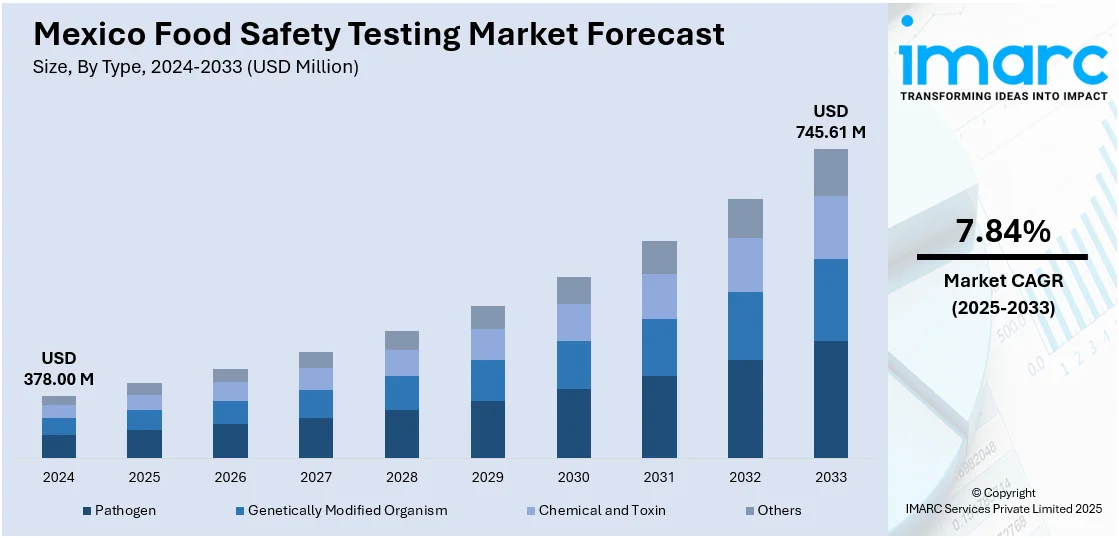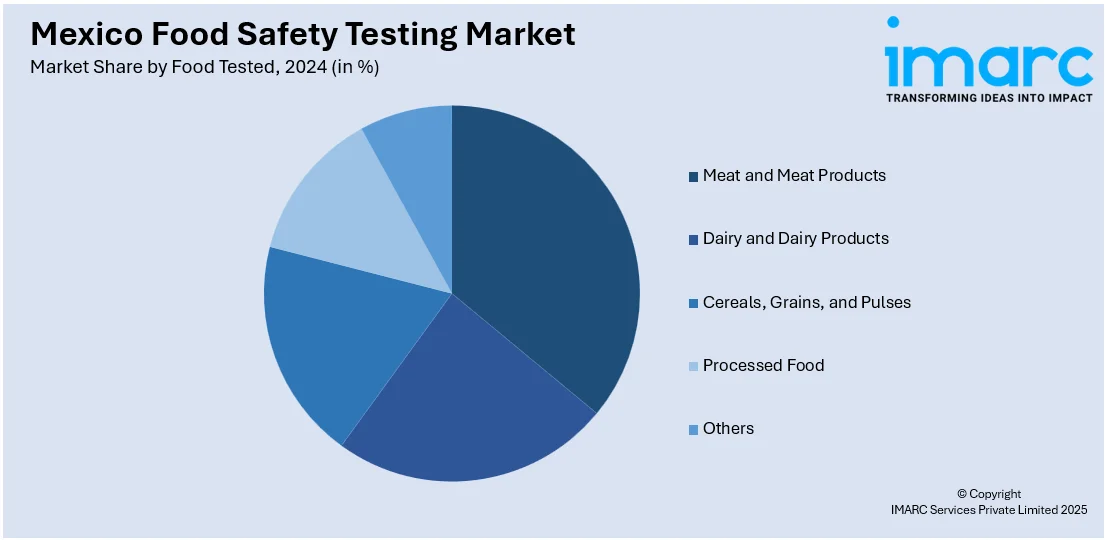
Mexico Food Safety Testing Market Size, Share, Trends and Forecast by Type, Food Tested, Technology, and Region, 2025-2033
Mexico Food Safety Testing Market Overview:
The Mexico Food Safety Testing Market size reached USD 378.00 Million in 2024. Looking forward, IMARC Group expects the market to reach USD 745.61 Million by 2033, exhibiting a growth rate (CAGR) of 7.84% during 2025-2033. The market is fueled by the robust agricultural export industry, particularly to those countries with demanding safety standards such as the U.S. and EU, and increased awareness among consumers about foodborne illnesses. Government actions and regulations regarding safety practices, and the rising use of cutting-edge testing technology like rapid detection and automation further contributes to the increasing Mexico food safety testing market share.
|
Report Attribute
|
Key Statistics
|
|---|---|
|
Base Year
|
2024 |
|
Forecast Years
|
2025-2033
|
|
Historical Years
|
2019-2024
|
| Market Size in 2024 | USD 378.00 Million |
| Market Forecast in 2033 | USD 745.61 Million |
| Market Growth Rate 2025-2033 | 7.84% |
Mexico Food Safety Testing Market Trends:
Technological Upgrades in Testing Techniques
The food safety testing market in Mexico is experiencing a tremendous change with the implementation of cutting-edge analytical technologies. Technologies like high-performance liquid chromatography (HPLC), mass spectrometry, and gas chromatography (GC) are becoming more common for the detection of various contaminants, such as pesticides, heavy metals, and pathogens. These technologies are more precise and sensitive than conventional testing techniques, allowing faster detection of possible hazards. Additionally, artificial intelligence (AI) and the Internet of Things (IoT) integration is boosting real-time monitoring. AI can predict possible safety hazards by evaluating large amounts of data, while IoT can offer real-time monitoring across the supply chain, from manufacturing to delivery. While this technological transformation enhances the effectiveness of food safety testing, it also assures that Mexican foodstuffs meet the high levels of safety necessary for domestic consumption and foreign export.

Regulatory Pressures and Export Compliance
Stringent food safety regulations implemented by the government significantly influences the Mexico food safety testing market growth. Regulatory bodies such as the Federal Commission for Protection against Sanitary Risks (COFEPRIS) impose strict requirements, in order to safeguard the quality of food products. Adherence to these laws is particularly significant for exporters targeting foreign markets, including the United States and European Union, each with its own strict food safety standards. For example, compliance with a Hazard Analysis and Critical Control Points (HACCP) guidelines and several other global food safety standards is required for foods such as avocados and seafood. Failure to comply can result in export refusal, economic loss, and loss of image for the country as a stable food supplier. Food producers, therefore, are making significant investments in full-cycle testing services in order to achieve these regulatory requirements and maintain competitiveness in the international market.
Movement Toward Organic and Sustainable Products
The consumer demand in Mexico is shifting toward organic and sustainably produced food products, while food producers are responding with more stringent safety testing procedures. This movement is being fueled by increasing awareness about health and environmental concerns related to traditional farming practices. Several consumers are demanding products that contain no synthetic chemicals, pesticides, and genetically modified organisms (GMOs), which has caused the demand for organic certification to increase. Producers are adopting broad testing protocols in order to address such consumer demands and distinguish their produce in the market. These tests involve testing for residues of pesticides, GMOs, and other pollutants that could taint the quality of organic produce. Consequently, Mexico's food safety testing market is also growing to support the increasing need for organic and sustainable food choices, with an emphasis on traceability and transparency along the food supply chain.
Mexico Food Safety Testing Market Segmentation:
IMARC Group provides an analysis of the key trends in each segment of the market, along with forecasts at the country and regional levels for 2025-2033. Our report has categorized the market based on type, food tested, and technology.
Type Insights:
- Pathogen
- Genetically Modified Organism
- Chemical and Toxin
- Others
The report has provided a detailed breakup and analysis of the market based on the type. This includes pathogen, genetically modified organism, chemical and toxin, and others.
Food Tested Insights:

- Meat and Meat Products
- Dairy and Dairy Products
- Cereals, Grains, and Pulses
- Processed Food
- Others
A detailed breakup and analysis of the market based on the food tested have also been provided in the report. This includes meat and meat products, dairy and dairy products, cereals, grains, and pulses, processed food, and others.
Technology Insights:
- Agar Culturing
- PCR-based Assay
- Immunoassay-based
- Others
The report has provided a detailed breakup and analysis of the market based on the technology. This includes agar culturing, PCR-based assay, immunoassay-based, and others
Regional Insights:
- Northern Mexico
- Central Mexico
- Southern Mexico
- Others
The report has also provided a comprehensive analysis of all the major regional markets, which include Northern Mexico, Central Mexico, Southern Mexico and others.
Competitive Landscape:
The market research report has also provided a comprehensive analysis of the competitive landscape. Competitive analysis such as market structure, key player positioning, top winning strategies, competitive dashboard, and company evaluation quadrant has been covered in the report. Also, detailed profiles of all major companies have been provided.
Mexico Food Safety Testing Market News:
- In June 2024, SGS, the worldwide leader in testing, certification, and inspection, announced that its laboratory located in Naucalpan, Mexico, was granted approval as a third-party testing lab certified by COFEPRIS (Federal Commission for the Protection against Sanitary Risks). This laboratory emphasizes the analysis of food, beverages, and consumer products.
Mexico Food Safety Testing Market Report Coverage:
| Report Features | Details |
|---|---|
| Base Year of the Analysis | 2024 |
| Historical Period | 2019-2024 |
| Forecast Period | 2025-2033 |
| Units | Million USD |
| Scope of the Report |
Exploration of Historical Trends and Market Outlook, Industry Catalysts and Challenges, Segment-Wise Historical and Future Market Assessment:
|
| Types Covered | Pathogen, Genetically Modified Organism, Chemical and Toxin, Others |
| Food Tested Covered | Meat and Meat Products, Dairy and Dairy Products, Cereals, Grains, and Pulses, Processed Food, Others |
| Technologies Covered | Agar Culturing, PCR-Based Assay, Immunoassay-based, Others |
| Regions Covered | Northern Mexico, Central Mexico, Southern Mexico, Others |
| Customization Scope | 10% Free Customization |
| Post-Sale Analyst Support | 10-12 Weeks |
| Delivery Format | PDF and Excel through Email (We can also provide the editable version of the report in PPT/Word format on special request) |
Key Questions Answered in This Report:
- How has the Mexico food safety testing market performed so far and how will it perform in the coming years?
- What is the breakup of the Mexico food safety testing market on the basis of type?
- What is the breakup of the Mexico food safety testing market on the basis of food tested?
- What is the breakup of the Mexico food safety testing market on the basis of technology?
- What is the breakup of the Mexico food safety testing market on the basis of region?
- What are the various stages in the value chain of the Mexico food safety testing market?
- What are the key driving factors and challenges in the Mexico food safety testing market?
- What is the structure of the Mexico food safety testing market and who are the key players?
- What is the degree of competition in the Mexico food safety testing market?
Key Benefits for Stakeholders:
- IMARC’s industry report offers a comprehensive quantitative analysis of various market segments, historical and current market trends, market forecasts, and dynamics of the Mexico food safety testing market from 2019-2033.
- The research report provides the latest information on the market drivers, challenges, and opportunities in the Mexico food safety testing market.
- Porter's five forces analysis assist stakeholders in assessing the impact of new entrants, competitive rivalry, supplier power, buyer power, and the threat of substitution. It helps stakeholders to analyze the level of competition within the Mexico food safety testing industry and its attractiveness.
- Competitive landscape allows stakeholders to understand their competitive environment and provides an insight into the current positions of key players in the market.
Need more help?
- Speak to our experienced analysts for insights on the current market scenarios.
- Include additional segments and countries to customize the report as per your requirement.
- Gain an unparalleled competitive advantage in your domain by understanding how to utilize the report and positively impacting your operations and revenue.
- For further assistance, please connect with our analysts.
 Request Customization
Request Customization
 Speak to an Analyst
Speak to an Analyst
 Request Brochure
Request Brochure
 Inquire Before Buying
Inquire Before Buying




.webp)




.webp)












